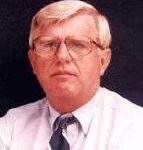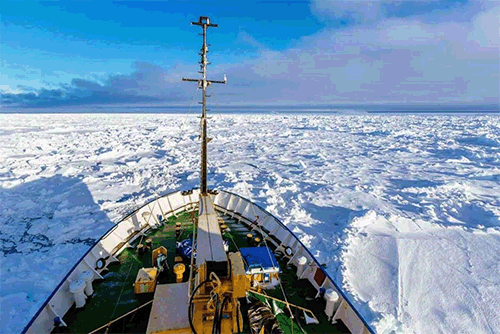Climate scientist Chris Turney of the University of New South Wales spent several years organizing an expedition to Antarctica to commemorate the 100th anniversary of theAustralasian Antarctic Expedition by Sir Douglas Mawson (1911-1913.) This expedition sailed into Commonwealth Bay directly below Australia and collected vast amounts of geographic and meteorological data. The courage and endurance of these Australians is an epic story that deserves reading by all interested in the history of the world’s true heroes. The name for the commemorative expedition is Australian Mawson Centenary Expedition of 2013-14.
An Australian Broadcasting Corporation (ABC) interview November 25, 2013, claimed the expedition cost $1.5 million. The presenter for the interview, Emma Alberici, wrote, “A modern-day scientist adventurer is about to undertake one of the largest Australian science expeditions to the Antarctic. Professor Chris Turney from the University of New South Wales and an 85-person team will spend two months trying to answer questions about how climate change in the frozen continent might already be shifting weather patterns in Australia. The $1.5 million expedition is driven by a unique 100-year-old legacy, the largely forgotten scientific records taken by Australia’s heroic Antarctic explorer, Sir Douglas Mawson.”
The interview said 86 individuals would go on the expedition; but this number had to be reduced to 54 due to the small Russian chartered Antarctic cruise ship, MV Akademik Shotkalskiy, having a capacity for only 54 passengers. Four passengers were members of the media — one from the BBC radio, two from The Guardian British news paper, and one from Radio New Zealand. The ship left New Zealand December 8, and traveled to within 60 kilometers of Commonwealth Bay due to the width of ice shelf off Antarctica at that time. The expedition carried vehicles that could travel over ice and visited the Mawson hut left over from the 1911 expedition. On December 24, wind-swept sea ice trapped the MVAkademik Shotkalskiy in a firm grip that required helicopter rescue of the 54 passengers ten days later.
Much world-wide media attention was given the ice-bound Russian ship and its 20 member crew and 54 passengers. Rescue attempts were made by the Chinese ice-breaker Xue Long to no avail. Attempts were made by the Australian ice-breaker Aurora Australis also to no avail. Rescue of the passengers was achieved on the tenth day by a helicopter from the Xue Long. The passengers were transferred to the Aurora Australis for transit back to Australia.
Chris Turney wrote an article during transit describing his trip “This was no Antarctic pleasure cruise,” published in Nature, vol. 505, January 2014, p. 133. As quoted in the article, Turney wrote:
The aim was to study various aspects of this vast, remote region to better understand its role in the Earth system, and communicate these results directly to the public. Yet most people only became aware of our work when we got stuck and had to be rescued.
Nowhere in Turney’s article was it mentioned global warming in the Antarctic was to be studied. No one seemed to pay attention to how Mawson sailed to shore at Commonwealth Bay in 1911, while sea ice prevented Turney from sailing closer than 60 kilometers of Commonwealth Bay shore in 2013. Is this a proof of increased atmospheric carbon dioxide from burning fossil fuels causing global warming?
An additional comment by Prof. Turney:
Never before has a science expedition reached out live to so many people from such a remote location. Public engagement was always a core theme.
Apparently Turney forgot moon landings were covered live on television decades earlier, The moon is quite a distance further from humans than Antarctica.
Australian writer Joanne Nova wrote a detailed description of the rescue attempts of the ill-founded Australian Mawson Centenary Expedition to show global warming had changed the Antarctic climate. Due to the blow to the theory increased carbon dioxide from burning fossil fuels the past 60 years has caused global warming, the reported story of the ice-boundAkademik Shokalskiy was changed from scientific expedition to tourist frolic. Of course, the media around the world failed to report the true story — which cost tax payers millions of dollars, mostly from Australia.
Jo Nova further reported the return of polar expedition members to Australia on January 21:
The ABC PR machine covers for their embarrassment — lest anybody think that climate scientists might be clueless. In the ABC’s world an “Australian Research Team” with “60 scientists” left because “scientists believe there is evidence of climate change.” After they got stuck in ice they didn’t predict, and looked like partying fools on an ill-prepared junket, the magic wand of ABC-apologia stopped using the term “climate” and they underwent a magical transformation to become a “Russian Passenger Ship.”
Basically a ship full of climate scientists left NZ, got stuck and turned into a Russian cruise ship.
The Australian Mowsan Centenary Expedition may be compared to other events in history where adventurer’s goals went beyond their achievable distances. In September 1944, Field Marshal Bernhard Law Montgomery thought he could end World War II in Europe by a 65-mile dash over five bridges to the Dutch city Arnhem on the Rhine River and outflank German defenses. This would be followed by an advance on Berlin. The attack ended in failure due to advancing forces being unable to cross the fifth Rhine River bridge at Arnhem. The war was probably prolonged due to this failure because of the vast expenditures of men and material.
Historian Cornelius Ryan published the epic history of this battle in 1974 with the title “A Bridge Too Far.” This was followed by the movie with the same name. The title came from the unconfirmed report British Lieutenant-General Frederick Browning had told Field Marshal Montgomery before the attack, “I think we may be going a bridge too far.”
Possibly the failed Australian Mowsan Centenary Expedition can be called “A Trip Too Far.” Will there be writers and actors lined up to portray this 21st century epic warning the planet of the dangers of global warming?





